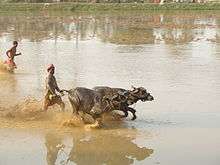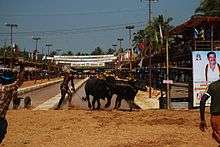Kambala


Kambala (Tulu: ಕಂಬಳ) is an annual Buffalo Race (he-buffalo) held traditionally under the auspices local land lords and households (Aramane, Beedu, Guthu/Mane, Dodmane) or Patel of village, in coastal Karnataka, India. The Kambala season generally starts in November and lasts until March. Since the last two decades nearly 18 kambalas are held under the banner of Kambala Samithi (Kambala Association). As of now, more than 45 he-buffalo races are held annually in Coastal Karnataka, even in smaller remote villages like Vandaru, Gulvadi etc.

Format

Kambala is traditionally a simple sport which provides much needed entertainment to the rural people.[1] The 'track' used for Kambala is a paddy field filled with slush and mud.[2] The contest generally takes place between two pairs of buffaloes, each pair raced in wet rice fields, controlled by a whip-lashing farmer.[3] In olden days, the winning pair of buffaloes was rewarded with coconuts and a bunch of plantains and nowadays, gold coins, silver coins are given;[4] in some competitions, cash award is also in vogue. Some organising committees award eight gram gold coin as first prize.[5] However, Kambala today has become an organised rural sport, with elobarate planning and timetable for Kambala at different places.[6] The "Kambala Committee" is formed and it usually arranges Kambala in several categories like Kane Halage, Hagga Hiriya, Hagga Kiriya,[6] Halage, Adda Halage[5] etc. People place massive bets on the buffaloes to win and one can witness more than 20,000 spectators in a well-organised Kambala, egging on and cheering the buffaloes to complete the race.
In traditional form of Kambala, racing is non-competitive, and he-buffalo pairs run one by one in paddy fields. A ritualistic approach is also there, as some agriculturists race their he-buffaloes for thanks giving (to god) for protecting their animals from diseases.(e.g.in Vandaru,Choradi villages)
Innovations are made in conducting kambala race and in some places day and night races are arranged under floodlights.[5]
Kadri kambala
Kadri Kambala used to be held at Kadri, Mangalore and it is called Devara Kambala (God's kambala) as it is associated with Sri Manjunatha Temple, Kadri, Mangalore.[6] This event was patronised by Alupa kings of Mangalore who were the rules 300 years ago and for this reason, Kadri kambala is also known as Arasu kambala (king's kambala).[6]
Care for buffaloes
The buffaloes developed for the race are carefully fed and some owners of the buffaloes have even built separate swimming pool for competing buffaloes.[7]
Opposition by animal lovers
Kambala has been criticised by animal lovers as they perpetuate cruelty[8] due to the use of whips on the racing buffaloes. Noted animal-rights activist, Mrs. Maneka Gandhi has expressed serious concerns about the ill treatment of buffaloes during the race. Kambala organisers, on their part, contend that if whips are not used on the buffaloes, they may not run with speed in the race. Government officials are advising the riders to be gentle on buffaloes and avoid using whips during the race.[8] Kambala still continues to draw rural crowd, as it used to draw large crowd, traditionally since last three hundred years.[9]
| Town/Village | Taluk | Date of Kambala | Appx. pairs | Image | Remakrs |
|---|---|---|---|---|---|
| Kadri[2] | Mangalore | December |  |
Competitive race:Much famed | |
| Vandaru | Kundapura | December | 300 |  |
Non competitive race |
| Pilikula[4] | Mangalore | December/January | 150[10] |  |
Competitive race |
| Choradi | Kundapura | December | 150 | Non competitive rural sport | |
| Gulvadi | Kundapura | December | 200 | Non competitive rural sport | |
| Baradi beedu | Karkala | December | |||
| Venur Permuda | Belthangadi | December | |||
| Moodabidri | Mangalore | December | |||
| Miyyaru | Karkala | January | |||
| Katapadi beedu | Udupi | January | |||
| Ikala Bava | Mangalore | February | |||
| Adve, Nandikur | Udupi | January | |||
| Pajir | Bantwala | February | |||
| Yeedu | Karkala | February | |||
| Puttur | Puttur | March | |||
| Jappina Mogaru[5] | Mangalore | March[5] | 150[5] | ||
| Uppinangadi | Puttur | March | |||
| Bangadi Kolli | Belthangadi | March | |||
| Thalapady Panjala | Mangalore | March/April | |||
| Althar | Udupi | March/April | |||
| Hokkadi goli | Bantwala | December | |||
| Handadi | Udupi | December | |||
| Vaddambettu[11] | Udupi | December[11] | |||
| Ajri[12] | Udupi | December | |||
| Mulki seeme | Mangalore | December |
Thonse Padumane Kambala Kemmannu, Padu Thonse. Udupi November
References
- ↑ Chaudhari, edited by Sarit K. Chaudhari, Sucheta Sen (2005). Primitive tribes in contemporary India : concept, ethnography and demography. New Delhi: Mittal Publications. p. 120. ISBN 9788183240260.
- 1 2 "Kadri comes alive with 'Kambala', fair". The Hindu. 13 December 2010. Retrieved 7 December 2012.
- ↑ Herzberg, Esther Grisham,Christine Ronan,editor-Roberta Dempsey (1997). South India (sb ed.). Glenview, IL: Good Year Books. p. 5. ISBN 9780673363596.
- 1 2 "Kambala". The Hindu. 26 December 2011. Retrieved 7 December 2012.
- 1 2 3 4 5 6 "Day and night kambala in Jeppinamogaru on March 19". The Hindu. 16 March 2011. Retrieved 7 December 2012.
- 1 2 3 4 "All set for Kambala season from tomorrow". The Hindu. 5 December 2009. Retrieved 7 December 2012.
- ↑ "Chill-out zone for buffaloes". The Hindu. 18 September 2012. Retrieved 7 December 2012.
- 1 2 "Pilikula Nisargadhama plays host to Kambala". The Hindu. 10 January 2012. Retrieved 7 December 2012.
- ↑ "Kadri Kambala witnesses confluence of Tulu culture". Deccan Herald. 2 December 2012. Retrieved 7 December 2012.
- ↑ "Grandeur marks Pilikula Kambala". The Hindu. 22 December 2008. Retrieved 7 December 2012.
- 1 2 "Federation says Koraga people made to beat drums during kambala". 15 December 2011. Retrieved 7 December 2012.
- ↑ "Ajri Kambala". Kundaprabha (weekly). 4 December 2012. Retrieved 7 December 2012.
13. http://www.mangalorean.com/news.php?newsid=401890&newstype=local
External links
| Wikimedia Commons has media related to Kambala. |
- Kambala
- Specialities -> Kambala
- A photo documentary on Kambala
- Modbidri Kambala
- Bola Chittaranjandas Shetty